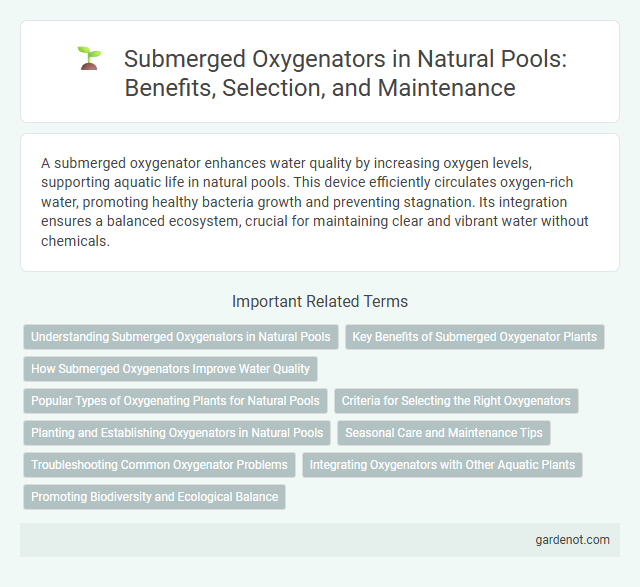A submerged oxygenator enhances water quality by increasing oxygen levels, supporting aquatic life in natural pools. This device efficiently circulates oxygen-rich water, promoting healthy bacteria growth and preventing stagnation. Its integration ensures a balanced ecosystem, crucial for maintaining clear and vibrant water without chemicals.
Understanding Submerged Oxygenators in Natural Pools
Submerged oxygenators play a crucial role in natural pool ecosystems by enhancing water quality through continuous oxygen infusion at the root zone of aquatic plants. These systems increase dissolved oxygen levels, promoting beneficial microbial activity that breaks down organic matter and reduces harmful algae growth. Understanding the function and placement of submerged oxygenators ensures optimal biological filtration and maintains a balanced, clear natural pool environment.
Key Benefits of Submerged Oxygenator Plants
Submerged oxygenator plants enhance water quality by efficiently increasing dissolved oxygen levels, promoting a healthier aquatic ecosystem. These systems reduce algae growth and prevent stagnation, supporting biodiversity and maintaining natural pool clarity. Their energy-efficient design lowers operational costs while minimizing environmental impact in natural pool maintenance.
How Submerged Oxygenators Improve Water Quality
Submerged oxygenators enhance water quality by increasing dissolved oxygen levels, which promotes aerobic bacterial activity essential for breaking down organic matter and controlling algae growth. This oxygenation process supports aquatic life and maintains a balanced ecosystem within natural pools. By improving oxygen circulation, submerged oxygenators reduce harmful anaerobic conditions, preventing the buildup of toxins and foul odors.
Popular Types of Oxygenating Plants for Natural Pools
Submerged oxygenators such as Hornwort (Ceratophyllum demersum), Anacharis (Elodea canadensis), and Waterweed (Egeria densa) are popular oxygenating plants for natural pools due to their efficient oxygen release and ability to improve water clarity. These aquatic plants help maintain balanced oxygen levels, reduce algae growth, and support healthy aquatic ecosystems. Their fast growth and adaptability make them ideal for sustaining natural pool environments with minimal maintenance.
Criteria for Selecting the Right Oxygenators
Selecting the right submerged oxygenator for a natural pool involves assessing factors such as oxygen transfer efficiency, durability against water chemistry variations, and maintenance requirements. Optimal oxygenators should ensure consistent oxygen supply to support aquatic life and prevent algae growth while minimizing energy consumption. Materials resistant to corrosion and biofouling prolong lifespan and reduce operational costs, making them ideal for sustainable natural pool ecosystems.
Planting and Establishing Oxygenators in Natural Pools
Planting and establishing submerged oxygenators in natural pools involves selecting native aquatic plants like Elodea canadensis or Vallisneria spiralis, which efficiently produce oxygen and support ecosystem balance. These oxygenators should be strategically placed in areas with sufficient light penetration to maximize photosynthesis and promote water clarity. Regular monitoring and gradual introduction help ensure the plants adapt well, enhancing natural filtration and sustaining aquatic life through improved oxygen levels.
Seasonal Care and Maintenance Tips
Seasonal care for a submerged oxygenator in a natural pool involves regular inspection and cleaning of the unit to prevent algae buildup and ensure optimal oxygen circulation. During colder months, it's essential to remove the oxygenator or use a winterizing cover to protect it from freezing and damage. Proper maintenance extends the lifespan of the oxygenator and supports balanced aquatic ecosystems by maintaining consistent oxygen levels.
Troubleshooting Common Oxygenator Problems
Submerged oxygenators in natural pools often encounter issues such as reduced oxygen diffusion, clogging from debris, and uneven water flow, which impact overall efficiency. Regular inspection and cleaning of the oxygenator membranes, along with ensuring proper water circulation, help maintain optimal oxygen levels. Identifying biofilm buildup early and adjusting flow rates can resolve common problems, promoting a balanced aquatic ecosystem.
Integrating Oxygenators with Other Aquatic Plants
Submerged oxygenators, such as hornwort and elodea, enhance water quality by releasing oxygen directly into the water column, supporting aquatic life and preventing algal blooms. Integrating these oxygenators with floating and marginal plants like water lilies and cattails creates a balanced ecosystem that naturally filters pollutants and stabilizes water chemistry. Combining diverse plant species maximizes oxygen production and nutrient uptake, promoting a healthy and clear natural pool environment.
Promoting Biodiversity and Ecological Balance
Submerged oxygenators enhance natural pools by increasing oxygen levels, which supports diverse aquatic life and stabilizes ecosystems. Their presence promotes beneficial microbial activity that breaks down organic matter, preventing algae overgrowth and maintaining water clarity. These oxygen-rich environments create habitats for various species, fostering biodiversity and sustaining ecological balance.
Submerged oxygenator Infographic

 gardenot.com
gardenot.com